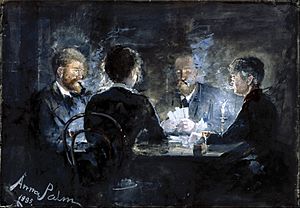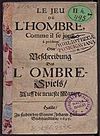Ombre facts for kids

L'Hombre (1887), a painting by Malthe Odin Engelstedt. The player in the center is Rasmus Malling-Hansen, Danish inventor of the typewriter.
|
|
| Origin | Spain |
|---|---|
| Alternative names | Hombre, Lomber |
| Type | Trick-taking |
| Players | 3 (4–5) |
| Skills required | Tactics and strategy |
| Cards | 40 cards |
| Deck | Spanish |
| Play | Counter-clockwise |
| Playing time | 20 min. |
| Random chance | Difficult |
| Related games | |
| Mensch • Quadrille • Solo • Tresillo • Zanga | |
Ombre (pronounced "omber") is a classic trick-taking card game that became very popular in the 1600s. Its name comes from the Spanish word hombre, meaning "man." It was once called "the most successful card game ever invented."
Ombre started in Spain around the late 1500s. It was one of the first card games known in Europe. It also inspired many other famous card games like Euchre and Solo Whist. Even though its rules were a bit tricky, Ombre quickly spread across Europe in the late 1600s. It became known as Lomber in Germany and Ombre in England. At one point, it was as popular and respected as contract bridge is today. Over time, Ombre led to a whole family of games, including Quadrille for four players and German Solo.
Contents
The Story of Ombre
Ombre is important in card game history because it was the first game where players could choose the trump suit. Before Ombre, the trump suit was usually chosen randomly. This idea of "bidding" for trumps was later used in other popular games like Skat and Tarot.
No one knows exactly where Ombre came from. But it arrived in England and France around the same time. People in France mentioned it in 1671, and rules for it were published in England in 1662. The game stayed very popular across Europe throughout the late 1600s and 1700s.
Over the years, Ombre changed a lot and had many different versions. In the 1700s, a new four-player game from France called Quadrille became more popular. Later, the English game Whist took its place. However, Ombre is still played today in places like Denmark, the Faroe Islands, and Iceland. Some versions like Tresillo and Rocambor are also played in parts of South America.
Some people believe that Ombre was brought to England by Catherine of Braganza, who was the Queen of King Charles II. She loved playing the game, and many people in English high society did too.
What's in a Name?
The name "Ombre" comes from a Spanish phrase: Yo soy el hombre. This means "I am the man." It was what the player who chose the trump suit would say. In English, the spelling changed from "Hombre" to "Ombre" because people thought it came from the French word ombre, meaning "shadow."
An old book about games, Compleat Gamester, mentions that there were different types of Ombre. The main one was called "Renegado," and only three people could play it. Another book, The Compleat Gamester (1722), even shows a picture of people playing Ombre. It was so popular that it inspired a special three-sided card table!
How to Play Ombre Renegado
Ombre is usually played by three people. One player, called the Ombre (the "man"), plays against the other two players. The game traditionally uses a 40-card Spanish deck. This deck has suits like coins, cups, swords, and clubs. But in Northern Europe, people often used French decks with spades, clubs, hearts, and diamonds. You can make a 40-card deck by taking out the eights, nines, and tens from a regular 52-card deck.
Card Ranks
The order of cards in Ombre changes depending on whether a black suit (spades or clubs) or a red suit (hearts or diamonds) is chosen as trumps.
The top three trump cards are always special and are called matadors:
- The Ace of Spades (called spadille)
- The 2 of the black trump suit OR the 7 of the red trump suit (called manille)
- The Ace of Clubs (called basto)
If a red suit is trumps, the Ace of Hearts or Diamonds (called "punto") is the fourth highest trump. But it's not a matador.
| If the trump suit is black: | 2 | K | Q | J | 7 | 6 | 5 | 4 | 3 | (11 cards) | |||||
| In a plain black suit: | K | Q | J | 7 | 6 | 5 | 4 | 3 | 2 | (9 cards) | |||||
| If the trump suit is red: | 7 | A | K | Q | J | 2 | 3 | 4 | 5 | 6 | (12 cards) | ||||
| In a plain red suit: | K | Q | J | A | 2 | 3 | 4 | 5 | 6 | 7 | (10 cards) |
Dealing the Cards
The player who draws the highest card from the deck deals first. Dealing and playing always move to the left (counter-clockwise). Before the game starts, the dealer puts five chips into a central pot, called the "pool." Then, the dealer gives each player nine cards, three at a time. The remaining thirteen cards are placed face down to form the "stock."
Bidding for Trumps
After the cards are dealt, players take turns bidding. Bidding is how players try to become the Ombre and choose the trump suit. The Ombre's goal is to win more tricks than either of the other two players.
The possible bids, from lowest to highest, are:
- Entrada: The Ombre chooses trumps, discards some cards, and draws new ones from the stock.
- Vuelta: The Ombre turns over the top card of the stock to decide trumps. Then they discard and draw cards.
- Solo: The Ombre chooses trumps but plays without discarding or drawing any new cards. This is the hardest bid.
Players can pass their turn to bid. If you pass, you cannot bid again later in that round. Each new bid must be higher than the last. The Ombre can discard as many cards as they want (unless playing Solo) and draw the same number from the stock. The other two players can also discard and draw cards to improve their hands.
Playing the Game
The player to the dealer's left starts the first trick. The person who wins a trick leads the next one. You must follow the suit that was led if you have a card of that suit. If you don't, you can play any card. The trick is won by the highest card of the suit led, or by the highest trump card played.
Matadors (the top three trumps) are special. You only have to play a matador if a higher matador is led. If you only have a lower matador, you don't have to play it if a trump is led.
If the Ombre wins the first five tricks in a row, they can claim victory right away. If they keep playing after five tricks, they are trying to win all nine tricks (called a "Vole"). Winning a Vole gives them extra points! If the Ombre thinks they can't win, they can give up before playing the fourth trick. But they cannot give up if they chose to play a "Solo" game.
Scoring Points
There are three main results in Ombre:
- Sacada: The Ombre wins more tricks than any other player. The Ombre takes the chips from the pool.
- Puesta: There is a tie for who won the most tricks. The Ombre has to pay chips into the pool.
- Codille: One of the opponents wins more tricks than any other player. The Ombre pays chips directly to that winning opponent.
If the Ombre wins (Sacada), they collect the pool and also get paid chips by each opponent. The amount depends on the bid:
- Entrada: 5 chips.
- Vuelta: 7 chips.
- Solo: 15 chips.
- Vole: If the Ombre wins all nine tricks, they get 25 extra chips (5 from the pot and 10 from each player).
- Primeras: If the Ombre wins the first five tricks and stops, they get 3 extra chips.
- Estuches: Extra payment if you have or are missing the top three trumps (matadors).
Penalties
If the Ombre loses (Puesta or Codille), they have to pay chips. The amount they pay can increase if they were trying for "Primeras" or "Estuches." If the Ombre tries for a "Vole" (all nine tricks) but fails, they pay a large penalty to each opponent.
Ombre Terms to Know
- Basto: The third highest matador (the Ace of Clubs).
- Codillo: When the Ombre loses, and an opponent wins more tricks.
- Entrada: A bid where the Ombre chooses trumps, discards, and draws new cards.
- Estuches: The three top cards of the game (the matadors).
- Manille: The second highest matador (the 2 of black trumps or 7 of red trumps).
- Ombre: The player who chooses trumps and tries to win the most tricks.
- Primeras: Winning the first five tricks in a row.
- Puesta: When the Ombre loses, and there's a tie for most tricks.
- Punto: The red Ace of the trump suit (if a red suit is trumps).
- Renege: To not follow suit when you should (this is usually a mistake or penalty).
- Sacada: When the Ombre wins more tricks than anyone else.
- Solo: A high bid where the Ombre chooses trumps but doesn't discard or draw cards.
- Spadille: The highest matador (the Ace of Spades).
- Vole: Winning all nine tricks in the game.
- Vuelta: A bid where the Ombre turns the top card of the stock to decide trumps, then discards and draws.
Other Ways to Play Ombre
Two-Player Ombre
Sometimes, Ombre can be played by just two people. To do this, one whole suit (like Diamonds or Hearts) is removed from the deck, leaving 30 cards. Each player gets eight cards, and the rest form the stock. The Ombre tries to win five tricks. If they tie with the other player (four tricks each), it's called "Remise." If the other player wins five tricks, the Ombre loses by "Codille."
Four-Player Ombre
In this version, usually only three players are active at a time. The fourth player sits out but still takes part in paying or receiving money after the game. If all three active players pass on bidding, the fourth player can pick up cards from the stock and play as the Ombre against the other three.
Five-Player Ombre
This version is called Cinquillo. Each of the five players gets eight cards, and no one can discard or draw new cards. The Ombre needs to win five tricks. Sometimes, the Ombre can "call a king" to ask another player to be their partner. If they win together, they share the winnings from the pool.
Ombre in Poetry
The game of Ombre is even mentioned in famous poems! For example, it appears in Alexander Pope's poem The Rape of the Lock. The poem describes a game of Ombre in such detail that experts have been able to figure out exactly how the cards were dealt and played.
An Ace of Hearts steps forth: The King unseen
Lurk'd in her hand, and mourn'd his captive Queen:
He springs to Vengeance with an eager pace,
And falls like thunder on the prostrate Ace.
The nymph exulting fills with shouts the sky;
The walls, the woods, and long canals reply
It's also mentioned in the famous Russian novel Eugene Onegin by Alexander Pushkin.
See also
- Spoil Five
Literature



